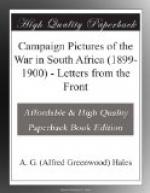The mine, which is named the “Monastery,” is very crudely worked; everything connected with it is primitive. A huge quarry, about 600 feet in circumference, and about 40 feet deep, had been opened up. There was nothing in it in the shape of lode or reef, but a large number of disconnected “stringers,” or leaders of rocky matter, in which diamonds are often found. At the bottom of the quarry the water lay fully eight feet deep, owing to the fact that the mine had lain unworked during the war. A vertical shaft had been sunk a little distance from the quarry to a depth of 150 feet, but there was a hundred feet of water in it, so that I am unable to say anything concerning the Monastery diamond mine at its lower levels. One or two tunnels had been drawn from the quarry into the adjoining country on small leaders, and from what I could gather from my guide diamonds had been discovered. Whilst I went below, I left my Kaffir boy on top to pick up what he could in the shape of rumour or gossip from the natives, and he informed me that the niggers had been the cause of the opening of the mine, they having found diamonds near the surface in some of the leaders, which consisted of a rock known in Australian mining circles as illegitimate granite. The white folk, fearing that the poor heathen might become debauched if they possessed too much wealth, had gathered those diamonds in—when they could—and later had started mining for the precious gems, with what success the heathen did not know. I tried the Dutchman on the same point, but I might as well have interviewed an oyster in regard to the science of gastronomy. He dodged around my question like a fox terrier round a fence, until I gave him up in despair. But, for all that, I rather fancy they have found diamonds round that way, only they don’t want the British to know anything about it.
Redwar with Rundle.
NearSenekal.
In our rear lies the little village of Senekal, a shy little place, seemingly top modest to lift itself out of the miniature basin caused by the circumambient hills. Khaki-clad figures, gaunt, hungry, and dirty, patrol the streets; the few stores are almost denuded of things saleable, for friend and foe have swept through the place again and again, and both Boer and Briton have paid the shops a visit. At the hotel I managed to get a dinner of bread and dripping, washed down with a cup of coffee, guiltless of both milk and sugar. But, if the bill of fare was meagre, the bill of costs made up for it in its wealth of luxuriousness. If I rose from the table almost as hollow as when I sat down, I only had to look at the landlord’s charges to fancy I had dined like one of the blood royal. Opposite the hotel stands the church, a dainty piece of architecture, fit for a more pretentious town than Senekal. It is fashioned out of white stone, and stands in its own grounds, looking calm and peaceful amidst all the bustle and blaze of war. Someone has turned all the seats out of the sacred edifice, preparatory to converting it into a hospital. The seats are not destroyed; they are not damaged; they are stacked away under a neighbouring verandah.




